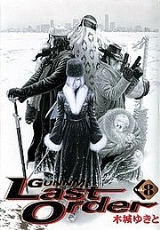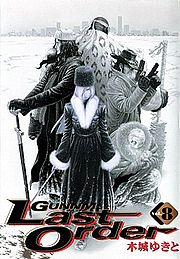
Type-V mutant
Encyclopedia

Battle Angel Alita: Last Order
Battle Angel Alita: Last Order, known in Japan as , is the continuation of the manga series Battle Angel Alita. It is created by Yukito Kishiro and tells the story of Alita continuing her quest to uncover her mysterious past.-Premise:Last Order continues from Volume 9 of Battle Angel Alita, but...
manga to refer to humans who are infected with a retrovirus
Retrovirus
A retrovirus is an RNA virus that is duplicated in a host cell using the reverse transcriptase enzyme to produce DNA from its RNA genome. The DNA is then incorporated into the host's genome by an integrase enzyme. The virus thereafter replicates as part of the host cell's DNA...
called the V-virus. The virus causes mutations in the DNA
DNA
Deoxyribonucleic acid is a nucleic acid that contains the genetic instructions used in the development and functioning of all known living organisms . The DNA segments that carry this genetic information are called genes, but other DNA sequences have structural purposes, or are involved in...
which result in the carriers exhibiting vampire
Vampire
Vampires are mythological or folkloric beings who subsist by feeding on the life essence of living creatures, regardless of whether they are undead or a living person...
-like characteristics, most notably pronounced canines and a thirst for blood. The origins of the V-virus have not been made clear, but Type-V mutants have existed throughout human history. Only in the late 20th century did advances in biology reveal that vampires were once humans who had been infected with the V-virus.
Characteristics
Type-V mutants suck human blood, are resistant to injury, and possess eternal youth, but have many characteristics that defy the common perceptions of what a vampire is. Among these are the abilities to go about in daylight, eat regular foods (even garlicGarlic
Allium sativum, commonly known as garlic, is a species in the onion genus, Allium. Its close relatives include the onion, shallot, leek, chive, and rakkyo. Dating back over 6,000 years, garlic is native to central Asia, and has long been a staple in the Mediterranean region, as well as a frequent...
, depending on their personal tastes), and cast reflections in reflective surfaces. Type-V mutants cannot transform themselves into creatures such as bats, do not need to rest in coffins or be surrounded by their native soil at night, and are not immortal, as they can die or be killed.
Interestingly, Type-V mutants can get sunburned or form stigmata
Stigmata
Stigmata are bodily marks, sores, or sensations of pain in locations corresponding to the crucifixion wounds of Jesus, such as the hands and feet...
if they are devout Christians when confronted with a crucifix
Crucifix
A crucifix is an independent image of Jesus on the cross with a representation of Jesus' body, referred to in English as the corpus , as distinct from a cross with no body....
. They gain additional abilities in the forms of physical strength and heightened senses, and depending on the individual, may also gain unique powers, referred to as "Satan's Honor", particularly if they live long lives. This is because they experience additional states of "Altered Shock" that grant them these additional abilities if they survive them. Because they lose their reproductive abilities, the only means of creating new Type-V mutants is to infect more humans. Nano-infused antidotes can prevent infection, taking the form of, for example, a piece of candy that Caerula Sanguis shows to Aga Mbadi when she confronts him in a secluded hallway on Ketheres.
While infection can be achieved through bites, the chances of an individual surviving the transmission of the V-Virus are extremely low. The body goes into a state of what the Cognate term "Altered Shock" for 70 hours, during which the victim experiences hallucinations, agonizing pain, a drop in blood pressure
Hypotension
In physiology and medicine, hypotension is abnormally low blood pressure, especially in the arteries of the systemic circulation. It is best understood as a physiologic state, rather than a disease. It is often associated with shock, though not necessarily indicative of it. Hypotension is the...
, convulsions
Seizure
An epileptic seizure, occasionally referred to as a fit, is defined as a transient symptom of "abnormal excessive or synchronous neuronal activity in the brain". The outward effect can be as dramatic as a wild thrashing movement or as mild as a brief loss of awareness...
, muscle rigidity
Hypertonia
Hypertonia a condition marked by an abnormal increase in muscle tension and a reduced ability of a muscle to stretch. It is caused by lesions to upper motor neurons in the central nervous system, which carry information from the central nervous system to the muscles and control posture, muscle...
, and stupor
Stupor
Stupor is the lack of critical cognitive function and level of consciousness wherein a sufferer is almost entirely unresponsive and only responds to base stimuli such as pain. This is often mistaken for delirium and treated with Haldol and or other anti-psychotic drugs...
. The survival rate is 1% among healthy individuals (between 19 and 25 years of age), and almost all children and the elderly die. A factor that may impact the survival rates is the temperature, as it decreases if this rises above 25°C during the onset of symptoms. The levels of growth and sex hormones are also thought to play a factor.
Means of death
After having survived Altered Shock, there are only three means left by which a Type-V mutant can die.Suicide
The suicide rate within ten years of infection can be as high as 60%. Because their thirst for blood (“carnivorous aggression”) becomes marked, infected victims are afflicted with psychological anguish as they are faced with the need to fill this thirst. If they were unwillingly infected, they turn to moral or religious reasons as a means of suppressing it, and the change that has come over them may prove unacceptable. Unless they are willing to think nothing of taking lives, they cannot continue to exist as Type-V mutants.Disease
Type-V mutants are prone to disease, in particular cancer, and cancer rates are 30 times normal within the first 50 years of infection. This particular susceptibility is likely due to the ageless cell division that their bodies undergo. The cancer rates however, drop 100 years after infection. A Society superstition held that once an individual reached 200 years of age, their likelihood of death was practically nil, barring conflict with other Type-V mutants.Murder
The Society will take necessary action against Type-V mutants who enjoy killing too much if they are unable to confine or shelter such individuals, usually by terminating them. Conflict with other Type-V mutants can also result in death once an individual is experienced and skilled enough to kill proficiently and not draw too much attention to themselves. Vilma Fachiri was targeted by assassins sent by the Society in their bid to expand their influence into AsiaAsia
Asia is the world's largest and most populous continent, located primarily in the eastern and northern hemispheres. It covers 8.7% of the Earth's total surface area and with approximately 3.879 billion people, it hosts 60% of the world's current human population...
, but was able to kill them all.
The Society
The Society was formed in the 17th century by Type-V mutant elders in response to Christian persecution throughout Europe during the Middle AgesMiddle Ages
The Middle Ages is a periodization of European history from the 5th century to the 15th century. The Middle Ages follows the fall of the Western Roman Empire in 476 and precedes the Early Modern Era. It is the middle period of a three-period division of Western history: Classic, Medieval and Modern...
. It served to organize Type-V mutants worldwide, teaching them how to integrate themselves into human society and not draw attention to themselves with excessive violence. Members of the Society referred to themselves as “the Cognate,” as the term “vampire” was considered derisive. The Society became influential enough to wield political influence, primarily in Europe
Europe
Europe is, by convention, one of the world's seven continents. Comprising the westernmost peninsula of Eurasia, Europe is generally 'divided' from Asia to its east by the watershed divides of the Ural and Caucasus Mountains, the Ural River, the Caspian and Black Seas, and the waterways connecting...
. It also attempted to gain power in Asia, but this was short-lived, as it was destroyed by the Catastrophe in ES 55, when a giant meteorite
Meteorite
A meteorite is a natural object originating in outer space that survives impact with the Earth's surface. Meteorites can be big or small. Most meteorites derive from small astronomical objects called meteoroids, but they are also sometimes produced by impacts of asteroids...
impacted Japan
Japan
Japan is an island nation in East Asia. Located in the Pacific Ocean, it lies to the east of the Sea of Japan, China, North Korea, South Korea and Russia, stretching from the Sea of Okhotsk in the north to the East China Sea and Taiwan in the south...
and wiped out civilization, causing a prolonged impact winter
Impact winter
An impact winter is a period of prolonged cold weather caused by the impact on the Earth of a large asteroid or comet. If such an impact occurred on land or the floor of a shallow sea, it could cause large amounts of dust or ash to be thrown into the Earth's atmosphere, blocking the Sun's light...
. Victor Bryon, the Society’s last known leader, survived, along with a handful of other Type-V mutants including Vilma Fachiri. Subsequent events over the next 60 years or so resulted in her being the sole surviving member of the Cognate left. By ES 173, 47 years after Arthur Farrell had established Star City, the future site of the Scrapyard, the truth about Type-V mutants has been lost to legend, and they have again become the vampires of folkore.
Notable Type-V mutants
- Caerula SanguisCaerula Sanguisis a fictional character in the Battle Angel Alita: Last Order manga by Yukito Kishiro, the sequel to Battle Angel Alita. Caerula is one of several Last Order characters adapted from fan submissions that were solicited by Kishiro from his readers for character ideas...
- Victor Byron
- Jacco
- Morse
- Zapolska

